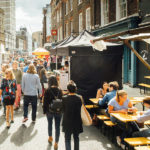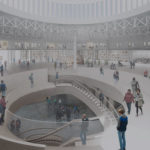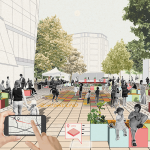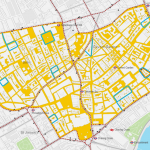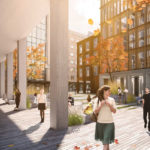Accessible-for-all, inclusive design….the next (and critical) step in this journey is equitability.
With COP26 underway and the need for decarbonisation driving radical change in transport, we have a huge opportunity to ensure more people can travel sustainably, while also creating safe, liveable, well-planned and equitable places.
As a highway designer, multi-disciplinary project manager and road safety engineer, I spend my working life looking at schemes through different lenses to understand how transport interventions will impact people.
The first step is often to look at how people travel, and the interactions between the different road user groups. In the last few years we’ve seen a shift in the industry where we’re assigning preference to the ‘lighter’ user groups (usually pedestrians and cyclists). This is a welcome change which I hope we can continue to implement and refine.
We are also pretty good at understanding that people’s travel behaviours and choices are affected by the purpose of their journeys, so people will use different options to – for example – commute, travel for leisure activity, be a tourist or travel long distances.
Where we could, as an industry, do better is thinking about how we consider the range of different people in each road user group and their abilities when we design or think about issues. For example, when removing a pedestrian island (eg to provide space for turning movement), how often do we think of the consequences for slower, more fragile users such as elderly, mobility impaired and very young pedestrians?
Transport graduates are taught the pragmatic way to plan and design networks, streets, junctions, cycle tracks, pedestrian crossings and urban places using relevant standards and guidance documents. But I cannot recall much guidance that asks designers to consider the needs of all these different people together and create inclusive places.
Thinking about equitable design
But inclusivity is not the end of the story. Let’s be honest, balancing the needs of different people is an incredibly complex task – and perhaps the place to start is in thinking about equitable design. This is not where everyone is considered equal, but where everyone is considered, and people are given what they need to use the space. Sometimes there may be conflicts between groups (eg visually-impaired pedestrians may use a kerb upstand to traverse a route, while some elderly people may enjoy a step-free pedestrian crossing) and decisions will need to be made, but the crucial part of decision making is in first finding out what people’s requirements really are.
What’s needed to be more equitable?
When we’re making changes to the street, it’s important to break down the user groups even further before we can understand their needs. When doing so, I try to think about all of the following:
• Pedestrians: the elderly, visually impaired, mobility impaired, deaf, children, learning disabilities, autistic, women, LBGT, tourists
• Cyclists: Confident space dominating, those preferring off-road, those requiring off-road, cycle with trailers, cycles for disabled
• Horse riders: Confident rider, inexperienced rider, inexperienced horse, confident horse
• Motor-cyclists: Confident, small engines only riders, sport bike riders
• Scooters & eScooters: owners, loaners, confident, learners
• Car drivers: new drivers, elderly, disabled (especially for parking), unfamiliar with the area
• Bus drivers: new drivers, drivers of large or bendy buses, tall buses, wide buses
• HGV drivers: foreign, tired, abnormal loads
This list isn’t exhaustive, but it does start to consider the different types of users and their different requirements in a more holistic way. It also opens the door for conversations with different people to understand their needs, share the successes (and failures) of previous schemes and help us think about how we could – as a profession – start to record and share specific user group requirements more effectively.
Transport feels like it is on the brink of a revolution; pressures from the climate emergency, over-crowding (which became especially pertinent during Covid times) and improvements in technology are coming together to make change much more likely. When we start to also think about equitability it’s clear that there is a massive up-side for us all in making the effort. As when we consider the needs of all, we often improve the quality of the design for all.
